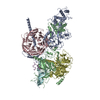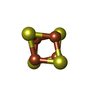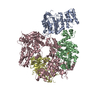+ Open data
Open data
- Basic information
Basic information
| Entry | Database: PDB / ID: 8vy3 | ||||||||||||
|---|---|---|---|---|---|---|---|---|---|---|---|---|---|
| Title | Human DNA polymerase alpha/primase - AavLEA1 (1:40 molar ratio) | ||||||||||||
 Components Components |
| ||||||||||||
 Keywords Keywords | REPLICATION / Human DNA poly alpha/primase / AavLEA1 / air-water-interface | ||||||||||||
| Function / homology |  Function and homology information Function and homology informationDNA primase AEP / ribonucleotide binding / DNA replication initiation / Telomere C-strand synthesis initiation / DNA/RNA hybrid binding / Inhibition of replication initiation of damaged DNA by RB1/E2F1 / regulation of type I interferon production / alpha DNA polymerase:primase complex / Polymerase switching / Processive synthesis on the lagging strand ...DNA primase AEP / ribonucleotide binding / DNA replication initiation / Telomere C-strand synthesis initiation / DNA/RNA hybrid binding / Inhibition of replication initiation of damaged DNA by RB1/E2F1 / regulation of type I interferon production / alpha DNA polymerase:primase complex / Polymerase switching / Processive synthesis on the lagging strand / lagging strand elongation / Removal of the Flap Intermediate / Polymerase switching on the C-strand of the telomere / mitotic DNA replication initiation / DNA replication, synthesis of primer / DNA strand elongation involved in DNA replication / DNA synthesis involved in DNA repair / leading strand elongation / G1/S-Specific Transcription / DNA replication origin binding / DNA replication initiation / Activation of the pre-replicative complex / Defective pyroptosis / double-strand break repair via nonhomologous end joining / nuclear matrix / protein import into nucleus / DNA-directed RNA polymerase activity / nuclear envelope / single-stranded DNA binding / 4 iron, 4 sulfur cluster binding / DNA-directed DNA polymerase / DNA-directed DNA polymerase activity / DNA replication / ciliary basal body / DNA repair / nucleotide binding / intracellular membrane-bounded organelle / chromatin binding / protein kinase binding / chromatin / nucleolus / magnesium ion binding / DNA binding / zinc ion binding / nucleoplasm / metal ion binding / nucleus / membrane / cytosol Similarity search - Function | ||||||||||||
| Biological species |  Homo sapiens (human) Homo sapiens (human) | ||||||||||||
| Method | ELECTRON MICROSCOPY / single particle reconstruction / cryo EM / Resolution: 2.98 Å | ||||||||||||
 Authors Authors | Abe, K.M. / Li, G. / Grant, T. / Lim, C.J. | ||||||||||||
| Funding support |  United States, 3items United States, 3items
| ||||||||||||
 Citation Citation |  Journal: Nat Commun / Year: 2024 Journal: Nat Commun / Year: 2024Title: Small LEA proteins mitigate air-water interface damage to fragile cryo-EM samples during plunge freezing. Authors: Kaitlyn M Abe / Gan Li / Qixiang He / Timothy Grant / Ci Ji Lim /  Abstract: Air-water interface (AWI) interactions during cryo-electron microscopy (cryo-EM) sample preparation cause significant sample loss, hindering structural biology research. Organisms like nematodes and ...Air-water interface (AWI) interactions during cryo-electron microscopy (cryo-EM) sample preparation cause significant sample loss, hindering structural biology research. Organisms like nematodes and tardigrades produce Late Embryogenesis Abundant (LEA) proteins to withstand desiccation stress. Here we show that these LEA proteins, when used as additives during plunge freezing, effectively mitigate AWI damage to fragile multi-subunit molecular samples. The resulting high-resolution cryo-EM maps are comparable to or better than those obtained using existing AWI damage mitigation methods. Cryogenic electron tomography reveals that particles are localized at specific interfaces, suggesting LEA proteins form a barrier at the AWI. This interaction may explain the observed sample-dependent preferred orientation of particles. LEA proteins offer a simple, cost-effective, and adaptable approach for cryo-EM structural biologists to overcome AWI-related sample damage, potentially revitalizing challenging projects and advancing the field of structural biology. | ||||||||||||
| History |
|
- Structure visualization
Structure visualization
| Structure viewer | Molecule:  Molmil Molmil Jmol/JSmol Jmol/JSmol |
|---|
- Downloads & links
Downloads & links
- Download
Download
| PDBx/mmCIF format |  8vy3.cif.gz 8vy3.cif.gz | 480.6 KB | Display |  PDBx/mmCIF format PDBx/mmCIF format |
|---|---|---|---|---|
| PDB format |  pdb8vy3.ent.gz pdb8vy3.ent.gz | 381.2 KB | Display |  PDB format PDB format |
| PDBx/mmJSON format |  8vy3.json.gz 8vy3.json.gz | Tree view |  PDBx/mmJSON format PDBx/mmJSON format | |
| Others |  Other downloads Other downloads |
-Validation report
| Summary document |  8vy3_validation.pdf.gz 8vy3_validation.pdf.gz | 1.1 MB | Display |  wwPDB validaton report wwPDB validaton report |
|---|---|---|---|---|
| Full document |  8vy3_full_validation.pdf.gz 8vy3_full_validation.pdf.gz | 1.2 MB | Display | |
| Data in XML |  8vy3_validation.xml.gz 8vy3_validation.xml.gz | 73 KB | Display | |
| Data in CIF |  8vy3_validation.cif.gz 8vy3_validation.cif.gz | 111.9 KB | Display | |
| Arichive directory |  https://data.pdbj.org/pub/pdb/validation_reports/vy/8vy3 https://data.pdbj.org/pub/pdb/validation_reports/vy/8vy3 ftp://data.pdbj.org/pub/pdb/validation_reports/vy/8vy3 ftp://data.pdbj.org/pub/pdb/validation_reports/vy/8vy3 | HTTPS FTP |
-Related structure data
| Related structure data |  43628MC  9c8uC  9c8vC M: map data used to model this data C: citing same article ( |
|---|---|
| Similar structure data | Similarity search - Function & homology  F&H Search F&H Search |
- Links
Links
- Assembly
Assembly
| Deposited unit | 
|
|---|---|
| 1 |
|
- Components
Components
-Protein , 2 types, 2 molecules AB
| #1: Protein | Mass: 49016.941 Da / Num. of mol.: 1 Source method: isolated from a genetically manipulated source Source: (gene. exp.)  Homo sapiens (human) / Gene: PRIM1 / Production host: Homo sapiens (human) / Gene: PRIM1 / Production host:  Trichoplusia ni (cabbage looper) / References: UniProt: P49642, DNA primase AEP Trichoplusia ni (cabbage looper) / References: UniProt: P49642, DNA primase AEP |
|---|---|
| #2: Protein | Mass: 50538.652 Da / Num. of mol.: 1 Source method: isolated from a genetically manipulated source Source: (gene. exp.)  Homo sapiens (human) / Gene: PRIM2, PRIM2A / Production host: Homo sapiens (human) / Gene: PRIM2, PRIM2A / Production host:  Trichoplusia ni (cabbage looper) / References: UniProt: P49643 Trichoplusia ni (cabbage looper) / References: UniProt: P49643 |
-DNA polymerase alpha ... , 2 types, 2 molecules CD
| #3: Protein | Mass: 128446.852 Da / Num. of mol.: 1 Source method: isolated from a genetically manipulated source Source: (gene. exp.)  Homo sapiens (human) / Gene: POLA1, POLA / Production host: Homo sapiens (human) / Gene: POLA1, POLA / Production host:  Trichoplusia ni (cabbage looper) / References: UniProt: P09884, DNA-directed DNA polymerase Trichoplusia ni (cabbage looper) / References: UniProt: P09884, DNA-directed DNA polymerase |
|---|---|
| #4: Protein | Mass: 49074.590 Da / Num. of mol.: 1 Source method: isolated from a genetically manipulated source Source: (gene. exp.)  Homo sapiens (human) / Gene: POLA2 / Production host: Homo sapiens (human) / Gene: POLA2 / Production host:  Trichoplusia ni (cabbage looper) / References: UniProt: Q14181 Trichoplusia ni (cabbage looper) / References: UniProt: Q14181 |
-Non-polymers , 2 types, 4 molecules 


| #5: Chemical | | #6: Chemical | ChemComp-SF4 / | |
|---|
-Details
| Has ligand of interest | N |
|---|---|
| Has protein modification | N |
-Experimental details
-Experiment
| Experiment | Method: ELECTRON MICROSCOPY |
|---|---|
| EM experiment | Aggregation state: PARTICLE / 3D reconstruction method: single particle reconstruction |
- Sample preparation
Sample preparation
| Component | Name: DNA Polymerase alpha/primase / Type: COMPLEX / Entity ID: #1-#4 / Source: RECOMBINANT | ||||||||||||||||||||
|---|---|---|---|---|---|---|---|---|---|---|---|---|---|---|---|---|---|---|---|---|---|
| Source (natural) | Organism:  Homo sapiens (human) Homo sapiens (human) | ||||||||||||||||||||
| Source (recombinant) | Organism:  Trichoplusia ni (cabbage looper) Trichoplusia ni (cabbage looper) | ||||||||||||||||||||
| Buffer solution | pH: 7.5 | ||||||||||||||||||||
| Buffer component |
| ||||||||||||||||||||
| Specimen | Embedding applied: NO / Shadowing applied: NO / Staining applied: NO / Vitrification applied: YES | ||||||||||||||||||||
| Vitrification | Instrument: FEI VITROBOT MARK IV / Cryogen name: ETHANE / Humidity: 95 % / Chamber temperature: 277 K |
- Electron microscopy imaging
Electron microscopy imaging
| Experimental equipment |  Model: Talos Arctica / Image courtesy: FEI Company |
|---|---|
| Microscopy | Model: FEI TALOS ARCTICA |
| Electron gun | Electron source:  FIELD EMISSION GUN / Accelerating voltage: 200 kV / Illumination mode: FLOOD BEAM FIELD EMISSION GUN / Accelerating voltage: 200 kV / Illumination mode: FLOOD BEAM |
| Electron lens | Mode: BRIGHT FIELD / Nominal defocus max: 2500 nm / Nominal defocus min: 1000 nm |
| Specimen holder | Cryogen: NITROGEN |
| Image recording | Electron dose: 50 e/Å2 / Film or detector model: GATAN K3 BIOQUANTUM (6k x 4k) |
- Processing
Processing
| EM software |
| ||||||||||||||||||||||||
|---|---|---|---|---|---|---|---|---|---|---|---|---|---|---|---|---|---|---|---|---|---|---|---|---|---|
| CTF correction | Type: NONE | ||||||||||||||||||||||||
| Symmetry | Point symmetry: C1 (asymmetric) | ||||||||||||||||||||||||
| 3D reconstruction | Resolution: 2.98 Å / Resolution method: FSC 0.143 CUT-OFF / Num. of particles: 856205 / Symmetry type: POINT | ||||||||||||||||||||||||
| Atomic model building | PDB-ID: 5EXR Accession code: 5EXR / Source name: PDB / Type: experimental model | ||||||||||||||||||||||||
| Refine LS restraints |
|
 Movie
Movie Controller
Controller












 PDBj
PDBj











